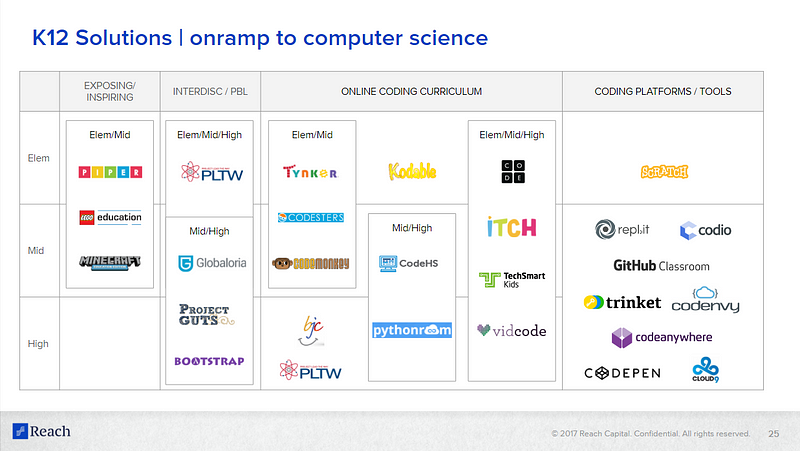by Jen Wu

The team at Reach has long recognized the value of K12 computer science education. Starting in 2013, while managing the NewSchools Seed Fund, we invested in Tynker and CodeHS, developers of K12 computer science curriculum that is accessible to teachers with a limited computer science background. Since then, we’ve expanded our CS footprint into consumer, higher ed, career development, and lifelong learning markets with investments in Piper, Gradescope, Holberton School, and Repl.it, all of which also have a presence in K12.
Given the explosion of activity in this space in recent years, we decided to step back and reflect on how the landscape has evolved. While options to learn how to code now seem limitless, why are there still so few schools that offer computer science? What holds us back from exposing all kids to computer science concepts at an early age and making computer science a realistic option as a field of study or a career? This onramp from K12 is critical to provide equitable access to economic opportunities in the future.
Field Report on K12 Computer Science
To shed light on these questions, we pulled together research from other organizations, interviewed educators on the front lines, and synthesized our findings in Reach’s Field Report on K12 Computer Science. The report presents compelling data about why this onramp matters so much to us. In addition, we dig deeper to understand what computer science looks like in our schools today. While obstacles to teaching computer science abound — including lack of qualified teachers and not having enough time to teach a subject that schools aren’t held accountable for — schools find creative ways to offer computer science in their course lineup. Learn about how they do, the people on the front lines of making it happen, and about challenges they face.
Read Reach’s Field Report on K12 Computer Science
Market Map of K12 Computer Science Solutions
We aso turn our attention to the plethora of solutions available to help schools teach computer science. We present these solutions in a map organized by grade level — elementary, middle, or high school — and by category which are defined by purpose:
- To expose students to computer science concepts and inspire them to learn more
- To integrate computer science concepts into other disciplines or as part of a project-based learning curriculum
- To teach students to code using an online curriculum
- To provide tools or platforms that facilitate teaching coding in a classroom environment

Considerations
Despite the many solutions available to students and computer science educators, insights from our research point to challenges that impede widespread adoption of these solutions in schools. These are considerations for both entrepreneurs developing solutions as well as educators trying to implement them.
For solutions targeting elementary and middle schools
- There is a lack of time in school day for non-tested subjects like computer science and art.
- Since computer science is a lower priority than tested subjects like math and English language arts, schools rely on teachers’ own initiative to make time for and teach computer science.
- Many teachers lack confidence in teaching computer science and don’t know how to get started.
For solutions that expose and inspire students
- Developing and facilitating these types of learning experiences is demanding on teachers and requires a high bar for motivation and expertise.
- Assessing these types of learning experiences can be challenging.
For project based and interdisciplinary solutions
- Because projects can be time-consuming and cross-subject, fitting them into traditional school schedules can be challenging.
- Assessing projects can be challenging and time-consuming.
For online coding curricula
- While many curricula address the challenge of the lack of experienced computer science teachers, they are often faced with a trade off between ease-of-use and
- Constrained learning experiences
- Teacher flexibility and student creativity
For coding platforms and tools
- These solutions cannot be used out-of-the-box to teach computer science; they provide only part of an overall solution.
- Using these tools requires a high bar for teachers to piece together both tools and curriculum.
Reach is eager to see policy changes and human capital solutions that can accelerate our ability to expand access to computer science education. We are hopeful for solutions that enable early exposure, open-ended and relevant learning experiences, and coherent pathways for continued learning. While significant challenges remain, we applaud both educators who are paving the way and entrepreneurs who are developing solutions that empower educators and students. Thank you for your hard work, and here’s to our collective, continued progress!
*Info on Reach Market Maps can be found here.
Special thanks to Reach interns Heejin Hahn, Nicole Orsak, Riley Carolan, and Olivia Danner for their thoughtful and valuable contributions to this work!


